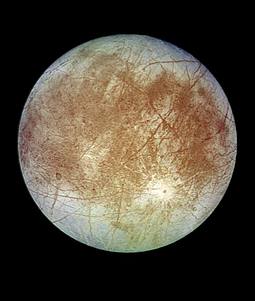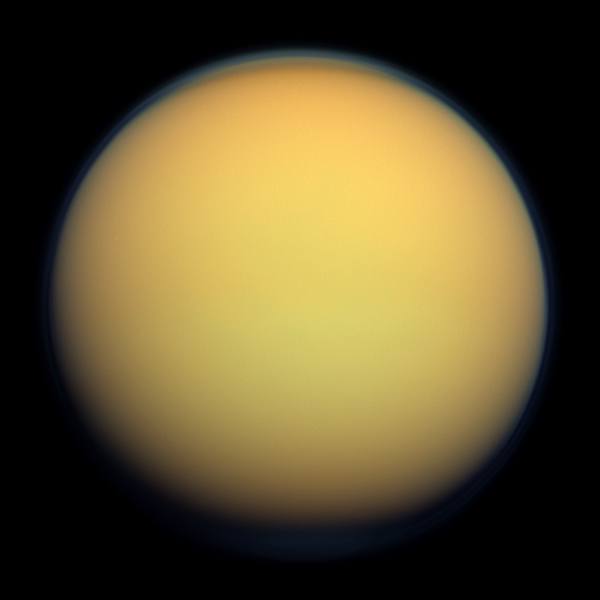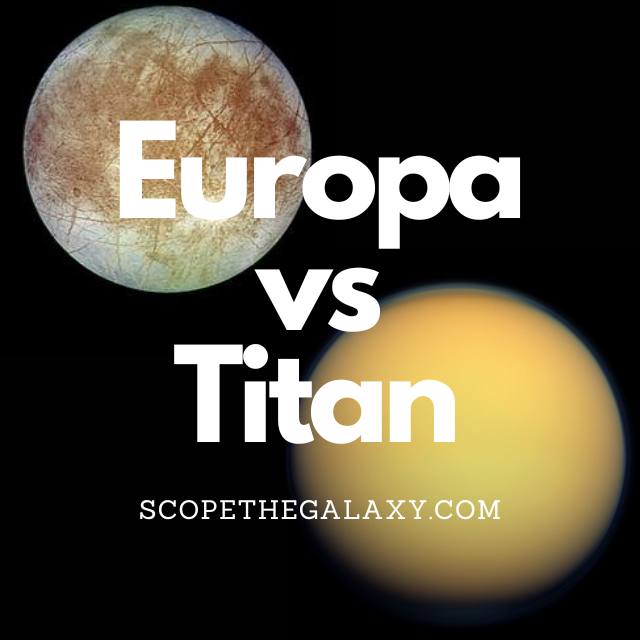*This post may contain affiliate links. This means we may make a commission if you purchase an item using one of our links*
The main differences between Europa and Titan are that Titan is the 2nd largest moon whilst Europa is 6th, Europa has water ice on its surface as opposed to the mostly rock based surface of Titan and that Europa is the most luminous moon in our solar system.
There are various other differences between these two so, continue reading if you’re looking for a more detailed look at each of these natural satellites along with a more in-depth look at their similarities and differences.
What Is The Moon Europa?
Table of Contents

Europa is the smallest of the Galilean moons, first discovered on 8th January 1610. The surface of this icy world is frozen, but scientists believe a watery ocean could lie beneath the surface. And in 2012, researchers found a possible water plume in the Southern polar region of Europa.
This research is yet to be confirmed; still, it gives us reasonable grounds to hypothesize that water could exist on this icy moon.
Estimates place Europa at around 4.5 billion years old (the same age as its planet, Jupiter), and its average distance from the Sun is approximately 780 million km.
It has a diameter of 3,121.6km, which makes it larger than Pluto but smaller than the Earth’s moon, and the maximum temperature is a chilly -160 degrees Celsius. In regards to mass, it measures in around 4.8 × 10^22 kg.
Europa takes three-and-a-half days to orbit its planet at an average distance of 670,900km, and it is tidally locked, meaning the same side of the moon always faces Jupiter.
Among the fascinating features of this ice moon is its incredibly reflective nature. The icy crust of this body provides a light reflectivity of 0.64 – the highest of any moon in the solar system.
Data from the Galileo spacecraft suggests that Europa is composed of an iron core, rocky mantle, and silicate rock (a similar composition to Earth).
The moon’s surface is covered in cracks, which many theorize could result from tidal currents beneath the surface. It is this potential of water – and of life – that keeps astronomers so interested in this moon.
Europa might be small, but astronomers estimate it holds two to three times more water than the Earth. In addition, this moon possesses the essential elements for life, such as carbon, oxygen, hydrogen, and nitrogen.
There may be no solar energy on this moon, but hydrothermal vents could provide energy, and tidal heating from Jupiter could provide a heat source and keep the moon stable enough for life to form. In addition, the liquid ocean is well protected from radiation from thick, icy surfaces.
What Is The Moon Titan?

Titan is Saturn’s largest moon and the second biggest moon in the entire solar system, with a diameter of 5,150km. This would make it even larger than the planet Mercury which is only 4,879km, and significantly larger than Pluto also.
As a result, Titan’s gravitational strength stands at around 1.352 m/s²
It is the only natural satellite in our solar system that is composed similarly to Earth, where it has a thick atmosphere made primarily of nitrogen (95%) along with smaller amounts of methane (5%). It has rivers and lakes on its surface along with a water cycle very similar to that of Earth, where essentially water evaporates and eventually lands on the satellites surface.
Therefore, much like Earth, Titan has a terrestrial based body but, there is a difference in their atmospheric pressure. The pressure on Titan’s surface is around 60% greater than that of Earth’s surface but, it isn’t nearly as dense.
Nevertheless, it is still far denser than most other bodies at 1.88 g/cm³. As a result, Titan’s mass is 1.345×10^23 kg.
In regards to its temperature, Titan is on the colder side where it averages around -179 degrees Celsius whilst its core’s temperature is actually very cold in comparison to other entities falling between 226 – 526 degrees Celsius.
As Saturn is the 6th farthest planet from the Sun, it will take Titan roughly the same amount of time to orbit the Sun, which would fall around 29.4 years.
It takes Titan 15 days and 22 hours to orbit Saturn. A day is 15 days and 22 hours also as it is tidally locked to the gas giant.
Similarities Between Europa And Titan
As both are natural satellites, Europa and Titan do share a few similarities, which include the following:
- Both have a hotter central core.
- Both have a rocky, terrestrial surface.
- Both are spherical in shape.
- Neither have rings surrounding them.
- Both are tidally locked to their planet.
- Both orbit their planet in an elliptical pattern.
- Neither have a magnetic field.
- Neither have tectonic plates.
Differences Between Europa And Titan
As for the differences between the two, they include the below:
- Titan is the 2nd largest moon whilst Europa is 6th as Titan is 5,150km whereas Europa has a diameter 3,121.6km.
- The average temperature on Titan is -179 degrees Celsius whilst Europa has a temperature of -160 degrees Celsius.
- Europa has a practically non-existent atmosphere whilst Titan’s atmosphere is far thicker as it is roughly 60% greater than Earth’s,
- Europa has water ice present on its surface whilst Titan has a water cycle, with rivers and lakes similar to that of Earth.
- Europa is 670,900km away from Jupiter on average whilst Titan’s average distance is 1.2 million km from Saturn.
- Europa is the most luminous moon in our solar system with a reflectivity 0.64 whilst Titan’s reflectivity isn’t nearly as bright with a reflectivity of around 0.27.
- Europa’s gravitational strength is 1.315 m/s² whilst Titan’s gravity is 1.352 m/s².
- Titan has a density of 1.88 g/cm³ whilst Europa’s density is 3.01 g/cm³.
- A day on Titan takes 15 days and 22 hours whilst a day on Europa takes 3.5 days.
- As both satellites are tidally locked to their planet, it takes them both the same as a day to orbit their planet meaning Europa takes 3.55 days and Titan completes an orbit in 15 days and 22 hours.
- In regards to mass, Europa’s is 4.8 × 10^22 kg whilst Titan’s is 1.345×10^23 kg.
Summary
Both are moons which is why Europa and Titan share a lot of similarities such as their elliptical orbital pattern, the fact both are tidally locked to their gas giant planet and how they are both terrestrial based objects.
With that being said, there are a lot of differences between the two also, such as their size, mass, density, the structure of their surface and beyond.

